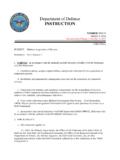Transcription of ACQUISITION TREND METRICS IN THE …
1 DAU PRESSTECHNICAL REPORT, TR 1-00 defense ACQUISITION UNIVERSITYDEFENSE SYSTEMS MANAGEMENT COLLEGEFORT BELVOIR, VIRGINIAACQUISITION TREND METRICSIN THEDEPARTMENT OF DEFENSEMAJOR WILLIAM J. SWANK, USAFDR. PAUL A. ALFIERICHARLES K. GAILEY IIIRAYMOND W. REIGO ctober 2000 Report Documentation PageForm ApprovedOMB No. 0704-0188 Public reporting burden for the collection of information is estimated to average 1 hour per response, including the time for reviewing instructions, searching existing data sources, gathering andmaintaining the data needed, and completing and reviewing the collection of information. Send comments regarding this burden estimate or any other aspect of this collection of information,including suggestions for reducing this burden, to Washington Headquarters Services, Directorate for Information Operations and Reports, 1215 Jefferson Davis Highway, Suite 1204, ArlingtonVA 22202-4302.
2 Respondents should be aware that notwithstanding any other provision of law, no person shall be subject to a penalty for failing to comply with a collection of information if itdoes not display a currently valid OMB control number. 1. REPORT DATE OCT 2000 2. REPORT TYPE N/A 3. DATES COVERED - 4. TITLE AND SUBTITLE ACQUISITION TREND METRICS in the Department of defense 5a. CONTRACT NUMBER 5b. GRANT NUMBER 5c. PROGRAM ELEMENT NUMBER 6. AUTHOR(S) 5d. PROJECT NUMBER 5e. TASK NUMBER 5f. WORK UNIT NUMBER 7. PERFORMING ORGANIZATION NAME(S) AND ADDRESS(ES) defense ACQUISITION university defense Systems Management CollegeFort Belvoir, VA 8. PERFORMING ORGANIZATIONREPORT NUMBER 9. SPONSORING/MONITORING AGENCY NAME(S) AND ADDRESS(ES) 10. SPONSOR/MONITOR S ACRONYM(S) 11. SPONSOR/MONITOR S REPORT NUMBER(S) 12. DISTRIBUTION/AVAILABILITY STATEMENT Approved for public release, distribution unlimited 13.
3 SUPPLEMENTARY NOTES 14. ABSTRACT 15. SUBJECT TERMS 16. SECURITY CLASSIFICATION OF: 17. LIMITATION OF ABSTRACT SAR 18. NUMBEROF PAGES 29 19a. NAME OFRESPONSIBLE PERSON a. REPORT unclassified b. ABSTRACT unclassified c. THIS PAGE unclassified Standard Form 298 (Rev. 8-98) Prescribed by ANSI Std Z39-18 ACQUISITION TREND METRICSIN THEDEPARTMENT OF DEFENSEM ajor William J. Swank, USAFDr. Paul A. AlfieriCharles K. Gailey IIIR aymond W. ReigOctober 2000 defense SYSTEMS MANAGEMENT COLLEGEPUBLISHED BY THE defense ACQUISITION university PRESSFort Belvoir, Virginia 22060-5565iiiEXECUTIVE SUMMARYFor five years the Office of the Secretary of defense (OSD) has funded the Engineering andManufacturing Development (EMD) Performance trends Research Project at the defense SystemsManagement College (DSMC). This research analyzes the cost, schedule and performance successof ACQUISITION Category I programs during the EMD phase of development.
4 This Executive Sum-mary contains the major conclusions and recommendations of the research effort to date. Support-ing rationale and details are contained in subsequent sections of this average cost overrun of programs within EMD for the period 1980 to 1996 was 40 per-cent; the average schedule overrun was 62 percent. The median cost overrun for the sameperiod was 20 percent; the median schedule overrun was 46 percent. The average performancesuccess rating was out of 5. The average duration of EMD for programs between 1980and 1996 was years. Figures are available by year groups and by slips, particularly of early test events, become the best early indicators of programs that must submit an exception SAR before they are through 50 percent of their actualEMD duration, it is most probable they will have a schedule overrun of more than two only Research, Development, Test and Engineering (RDT&E) costs during EMD pro-vides a comparable and possibly better analysis of the true EMD cost growth percentage thanusing the combined RDT&E and Procurement costs when interested in managerial complexity of these ACQUISITION programs makes it difficult to attribute a particular out-come to any set of two (or even three) program OSD/Office of ACQUISITION Resources and Analysis maintains a single TREND metric, MajorDefense ACQUISITION Program Cost Growth.
5 This is a required macro-economic indicator butdoes not reflect trends in program DSMC Research project is the only system of METRICS that uniquely combines performancedata (operational test results) with general management data (cost and schedule) within quarterly defense ACQUISITION Executive Summary process and report is the Departmentof defense (DoD) method to address potential problems (early warning). It appears to beworking well and it should continue to be used by the top ACQUISITION managers within appears to be a lack of sufficient TREND data available in DoD to determine if acquisitionmanagement is improving. This research project, or equivalent, could be used as an additionaltrend metric and should be year is the first year sufficient programs that have benefited from the ACQUISITION Reform(AR) initiatives will have completed EMD and their EMD success can be compared to pre-ARprograms using the data in the DSMC public perceives DoD ACQUISITION as inefficient.
6 However, there is data showing that DoDacquisition is relatively good when compared to other public and private major perception is as important as reality, it is recommended that the relative efficiency ofDoD ACQUISITION be majority of programs have schedule overruns of less than 85 percent according to schedule/overrun data, while fewer than a third of the programs had schedule overruns of more than 125percent. This appears to represent a significant difference between the two groups. Furtheranalyses should consider treating these groups analysis of program outcomes should be performed, to isolate significant factorsor combinations of factors in success or OF CONTENTST itle Page .. iExecutive Summary .. iiiTable of Contents .. vList of Figure .. viAcronym List .. Relative Cost Growth .. Indicators .. , Schedule and Performance as Early Warnings .. TREND Metric .. vs. Median.
7 DAES Process and Report .. of EMD Costs .. of First Exception SAR .. 910. Test Type Errors .. 1011. Review of the Technical Section of the SAR .. 1112. ACQUISITION Reform Impact .. 1213. Use of OA during EMD .. 1414. Program Characterization .. 1515. The Right Stuff .. 19 Authors Notes ..20 LIST OF of Actual to Planned EMD Cost and Schedule .. Growth in Major Projects (TASC) .. Cost Growth Metric Background .. Cost Growth Metric Results for Past 6 Years .. ACQUISITION Executive Summary (DAES) .. Process .. (Percentage) into EMD of First Exception SAR .. of ACQUISITION Reform on Program EMD .. 13viviiACRONYM LISTACATA cquisition CategoryA/CAircraftADCAPA dvanced CapabilityAFOTECAir Force Operational Test and Evaluation Center AMRAAMA dvanced Medium Range Air-to-Air MissileAPAMAnti-Personnel Anti-MaterielAPBA cquisition Program BaselineARAcquisition ReformAR&AOffice of ACQUISITION Resources and Analysis (OSD)
8 ASPJA irborne Self-Protection JammerATACMSArmy Tactical Missile SystemC/SCSCCost/Schedule Control Systems CriteriaDABD efense ACQUISITION BoardDAESD efense ACQUISITION Executive SummaryDoDDepartment of DefenseDOT&EDirector, Operational Test and EvaluationDSBD efense Science BoardDSMCD efense Systems Management CollegeEMDE ngineering and Manufacturing DevelopmentFMTVF amily of Medium Tactical VehiclesIOT&EInitial Operational Test and EvaluationIPTI ntegrated Product TeamJROCJ oint Requirements Oversight CouncilJSOWJ oint Standoff WeaponJSTARSJ oint Surveillance Target Attack Radar SystemJTIDSJ oint Tactical Information Distribution SystemLRIPLow Rate Initial ProductionLFT&ELive Fire Test and EvaluationMDAPM ajor defense ACQUISITION ProgramM/SMilestoneMM III GRPM inuteman III Guidance Replacement ProgramPMProgram ManagerPMOP rogram Management OfficeOAOperational AssessmentORDO perational Requirements DocumentOSDO ffice of the Secretary of DefenseOTOperational TestingRDT&EResearch, Development, Test and EvaluationSARS elected ACQUISITION ReportSMART-TSecure, Mobile Antijam, Reliable.
9 Tactical TerminalT&ETest and EvaluationTEMPTest and Evaluation Master PlanUSD(A&T)Office of the Deputy Under Secretary of defense for ACQUISITION and Technology11. BackgroundIn 1994 the Science Advisor to the DOT&E, or Director, Operational Test and Evaluation,asked the defense Systems Management College Test and Evaluation Department (DSMC T&E) toresearch the relationship, if any, between the number of test articles used in the Engineering andManufacturing Development (EMD) phase of a program ACQUISITION , and the success of that pro-gram in EMD. Since determining the number of test articles required is a difficult trade-off amongseveral factors, the DOT&E wanted to know if data was available that would help in making thisimportant decision. Indications were that factual METRICS relating to the subject were specifically detailed in this report, all METRICS and author s conclusions are detailed inDSMC Press Technical Report TR 1-99.
10 (See Bibliography.) Figure 1, also contained in TR 1-99,shows the average cost and schedule overruns as ratios of planned to actual figures. To obtainoverrun percentages, subtract 1 from the values on the axes. The average actual duration of EMDfor any program, for any year in which that program s EMD phase ended, can be found in thedatabase section of TR 1. Ratio of Actual to Planned EMD Cost and ScheduleRatio of Actual to Planned EMD CostRatio of Actual to Planned EMD andschedulewithin 100%overrun ofcost andschedulen = DoD Relative Cost GrowthFigure 2 indicates the cost growth (overruns) of Department of defense (DoD) major weaponsystems compared to other complex public and private sector projects. It shows that DoD cost over-runs are relatively small when compared to the majority of the other projects shown.













